Suspension training is a total-body workout using bodyweight exercises, enhancing strength, balance, and flexibility. Versatile for all fitness levels, it’s widely used by professionals and enthusiasts alike;
1.1 What is Suspension Training?
Suspension training is a versatile fitness method using suspended equipment to engage bodyweight in dynamic movements. It enhances strength, balance, and flexibility through unstable resistance, targeting stabilizer muscles. Scalable for all fitness levels, it combines functional movements like squats, rows, and presses. Popularized by systems like TRX, suspension training offers a full-body workout that’s portable and effective for improving overall physical fitness and coordination.
1.2 Benefits of Suspension Training
Suspension training enhances strength, flexibility, and balance by engaging the core in every exercise. It improves joint stability and muscle endurance while being low-impact, reducing injury risk. Portable and versatile, it suits all fitness levels, offering a time-efficient full-body workout. The functional movements also boost coordination and athletic performance, making it ideal for both rehabilitation and advanced training goals.
1.3 A Brief History of Suspension Training
Suspension training originated in the 1990s, developed by Navy SEAL Randy Hetrick using a parachute harness. He created the first TRX system to provide portable, effective workouts. Its popularity grew rapidly, becoming a favorite among athletes and fitness enthusiasts worldwide for its versatility and efficiency in building strength and stability.

TRX Suspension Trainer
The TRX Suspension Trainer, developed by Navy SEAL Randy Hetrick, uses body weight for resistance. It provides versatile workouts that enhance strength, flexibility, and balance.
2.1 What is the TRX Suspension Trainer?
The TRX Suspension Trainer is a versatile fitness tool developed by Navy SEAL Randy Hetrick. It uses adjustable straps and your body weight for resistance, offering a full-body workout. Portable and durable, TRX helps improve strength, flexibility, and balance. Suitable for all fitness levels, it supports various exercises targeting different muscle groups, making it ideal for both home and gym use.
2.2 Components of the TRX System
The TRX Suspension Trainer consists of durable nylon straps with adjustable buckles, two ergonomic handles, and a foot cradle. It also includes a cam buckle for quick adjustments and a anchor point or frame for setup. These components work together to provide stability and versatility for various exercises, ensuring a safe and effective workout experience.
2.3 How to Set Up the TRX Suspension Trainer
To set up the TRX Suspension Trainer, find a sturdy anchor point and attach the suspension straps. Adjust the straps to the desired length using the cam buckles. Ensure the system is secure by tightening the buckles and testing the setup. For added safety, use a backup line or door anchor. Always test the stability before use.
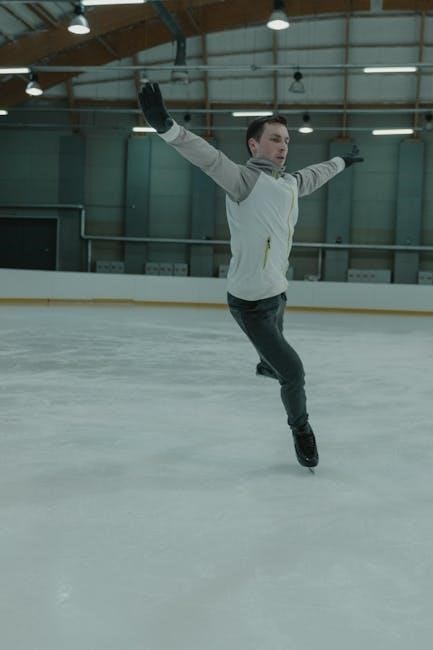
Core Exercises for Suspension Training
Suspension training is excellent for targeting the core, engaging stabilizer muscles to enhance posture and overall stability. It offers a variety of exercises to build strength effectively.
3.1 Fundamental Core Exercises
Fundamental core exercises in suspension training include planks, knee tucks, and crunches. These movements target the abs, obliques, and lower back, improving stability and strength. Suspension planks engage the entire core, while knee tucks focus on the lower abs. Crunches work the upper abs, and side plank variations target the obliques. These exercises form the foundation for more advanced core workouts.
3.2 Advanced Core Exercises
Advanced core exercises in suspension training involve dynamic movements like pike planks, side crunches, and hanging leg raises. These exercises challenge stability, engage deeper muscles, and improve functional strength. They often combine rotation, flexion, and extension, targeting the entire core. Advanced movements require precise control and build upon foundational techniques, offering increased intensity for experienced trainees aiming to enhance performance and athleticism.
3.3 TRX Core Workout Routine
A TRX core workout routine combines exercises like planks, crunches, and rotations to target the abdominals, obliques, and lower back. Start with foundational moves, then progress to dynamic variations. Aim for 3-4 sets of 12-15 reps per exercise, focusing on controlled movements. This structured approach enhances core stability, improves posture, and boosts overall athletic performance efficiently.
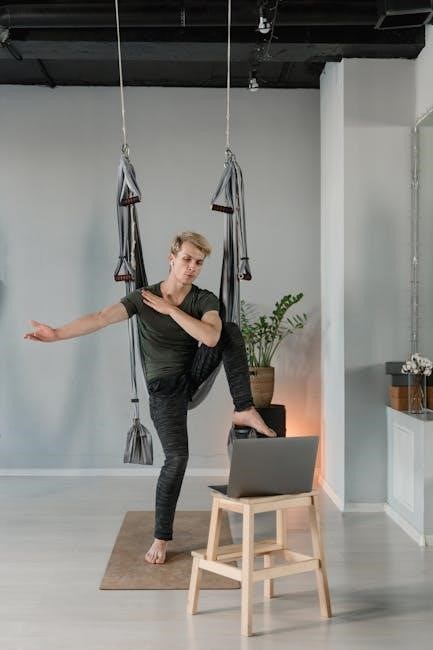
Lower Body Exercises
Suspension training targets legs, glutes, and calves through exercises like TRX squats, lunges, and leg presses. These movements build functional strength, improve balance, and enhance mobility efficiently.
4.1 Suspension Squats and Lunges
Suspension squats and lunges effectively target the quadriceps, hamstrings, and glutes. These exercises improve balance and stability while engaging the core. By adjusting body position, users can modify intensity. Proper form ensures maximum benefits and reduces injury risk. Incorporating variations, like single-leg squats or lateral lunges, challenges different muscle groups and enhances overall lower body strength progressively.
4.2 TRX Leg Exercises for Strength
TRX leg exercises, such as leg curls, calf raises, and single-leg exercises, build strength and stability. Using suspension straps, these movements challenge the hamstrings, quads, and calves while engaging the core. Adjusting angles and resistance levels allows for progression. Proper form ensures effectiveness and safety, making these exercises suitable for varying fitness levels to enhance lower body power and endurance.
4.3 Variations for Different Fitness Levels
Modify suspension exercises to suit individual fitness levels. Beginners can reduce resistance by adjusting foot position or using assistance. Intermediate users can increase intensity with single-leg movements or deeper angles. Advanced trainees can add plyometric elements or combine exercises for greater challenge. These variations ensure safe progression while maintaining effectiveness for all fitness levels.
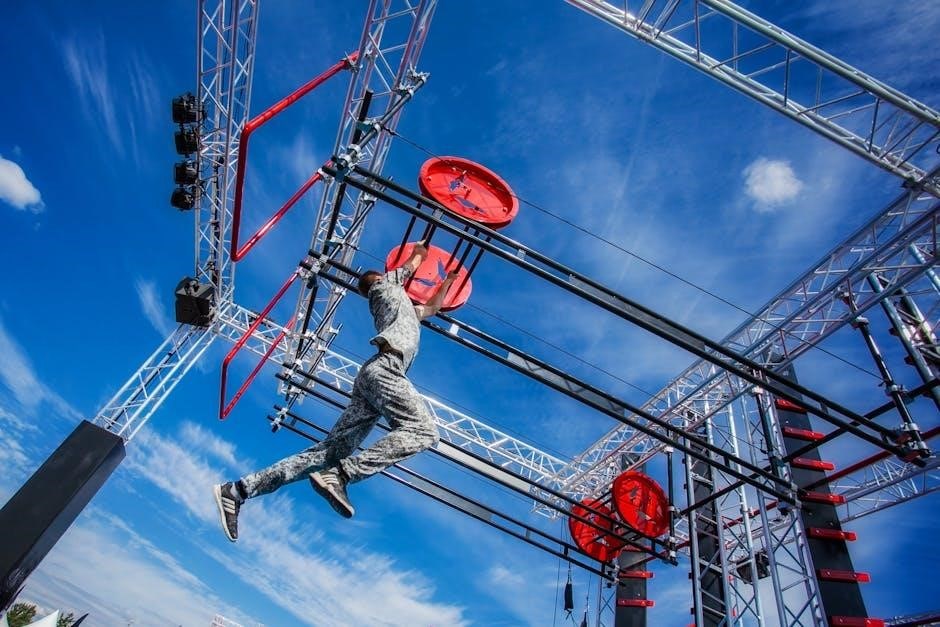
Upper Body Exercises
Suspension training targets the chest, shoulders, and triceps with functional movements. It enhances strength, stability, and endurance, offering scalable exercises for any fitness level.
5.1 TRX Push Exercises
TRX push exercises, like chest presses and pushaways, target the chest, shoulders, and triceps. These movements engage the core for stability while improving strength and endurance. By adjusting body position, users can modify resistance levels, making these exercises accessible for beginners and challenging for advanced trainees. They promote functional movement and overall upper body development.
5.2 TRX Pull Exercises
TRX pull exercises, such as rows and lat pulldowns, target the back, shoulders, and arms. These movements enhance posture, improve grip strength, and build muscular endurance. By leveraging body weight and adjusting angles, users can customize resistance to suit fitness levels. Pull exercises are essential for balanced upper body development and functional strength, making them a cornerstone of suspension training routines.
5.3 Combined Upper Body Workouts
Combined upper body workouts integrate TRX push and pull exercises for a balanced routine. These circuits target chest, shoulders, and back muscles simultaneously, enhancing coordination and efficiency. Example exercises include push-pull combinations, chest presses with rows, and overhead tricep extensions paired with bicep curls. This approach maximizes time, improves cardiovascular fitness, and ensures comprehensive upper body development.

Full-Body Workout with Suspension Training
Suspension training offers efficient full-body workouts by engaging multiple muscle groups simultaneously. It improves coordination, strength, and cardiovascular fitness while targeting core, upper, and lower body effectively.
6.1 Circuit Training with TRX
Circuit training with TRX combines dynamic exercises in a sequence to maximize efficiency. It improves cardiovascular fitness, muscle endurance, and coordination, while engaging the entire body. By alternating between upper and lower body movements, users maintain intensity and balance. This approach is ideal for time-efficient workouts, enhancing overall physical conditioning and mental focus through varied and challenging routines.
6.2 Combining Upper and Lower Body Exercises
Combining upper and lower body exercises in suspension training creates balanced, full-body workouts. This approach enhances coordination, strength, and efficiency. For example, pairing TRX push exercises with suspension squats engages multiple muscle groups simultaneously. This integration challenges the body holistically, improving overall fitness while reducing workout duration, making it ideal for those seeking comprehensive conditioning in less time.
6.3 Time-Efficient Full-Body Routines
Suspension training allows for quick, effective full-body workouts by minimizing transition time between exercises. Circuit-style routines combining push, pull, and lower-body movements maximize efficiency. For example, alternating between TRX Chest Press and Suspension Lunges engages the entire body in a single session. This approach optimizes time, making it ideal for busy individuals seeking a comprehensive workout in minimal time.
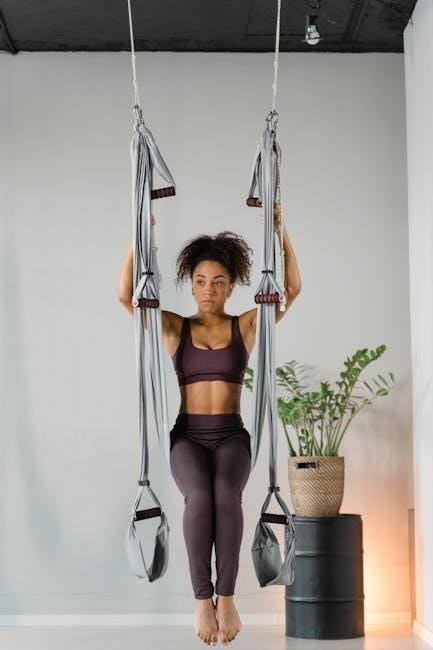
Safety and Form
Proper form is essential for injury prevention and effectiveness. Always engage your core, adjust straps for height, and perform controlled movements. Ensure equipment is secure and start with slower tempos to maintain form. Prioritize technique over speed to maximize results and minimize risks during suspension training exercises.
7.1 Proper Form and Technique
Proper form and technique are vital for effective and safe suspension training. Engage your core, maintain a neutral spine, and adjust straps to appropriate lengths. Use controlled movements, keep your body tight, and focus on slow, deliberate tempos. Avoid rounding shoulders, ensure hands or feet are correctly positioned, and engage the correct muscles to target desired areas effectively.
7.2 Safety Tips for Suspension Training
Always inspect suspension equipment for wear and tear. Ensure anchor points are sturdy. Begin with a dynamic warm-up. Use spotters, especially for challenging moves. Follow setup instructions precisely. Adjust straps correctly for each exercise. Maintain a clear workout space. Wear proper footwear and secure clothing. Stay hydrated and listen to your body. Avoid overexertion and rest when needed. Consult a professional if unsure.
7.3 Common Mistakes to Avoid
Common mistakes include improper form, neglecting warm-ups, and using the wrong stance. Overloading exercises too quickly can lead to injury. Inconsistent training and ignoring core engagement are also pitfalls. Poor strap adjustment and lack of focus on controlled movements reduce effectiveness. Avoid sacrificing form for repetitions, and ensure proper setup for each exercise to maximize results and safety.
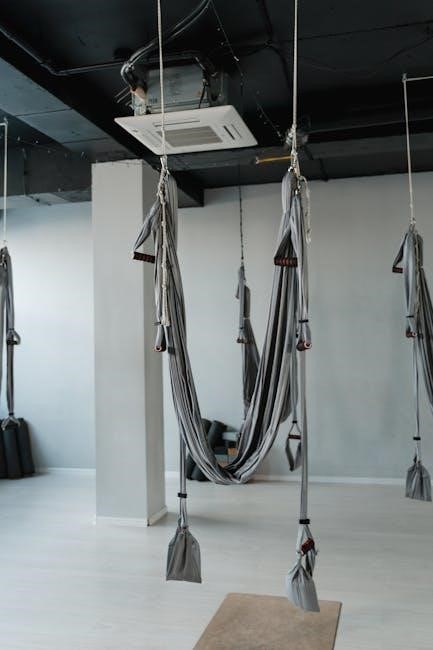
Advanced Suspension Training Exercises
Advanced Suspension Training Exercises involve dynamic movements, plyometrics, and resistance bands. These techniques build on foundational skills, enhance strength, and improve flexibility. Ideal for experienced users seeking intensity.
8.1 Dynamic Movements and Plyometrics
Dynamic movements and plyometrics in suspension training incorporate explosive actions to boost power and reactivity. Exercises like TRX plyo push-ups or box jumps enhance muscle recruitment and coordination. These advanced techniques target the core, improving stability while increasing intensity. Plyometrics add a functional dimension, making workouts dynamic and effective for all fitness levels and sports training.
8.2 Incorporating Resistance Bands
Incorporating resistance bands into suspension training adds an extra layer of challenge. By attaching bands to the TRX or using them in conjunction with suspension exercises, you can increase tension and target muscles more effectively. This combination enhances strength, endurance, and flexibility, while allowing for greater variety in your workout routines. It’s an excellent way to progress your training and achieve advanced fitness goals.
8.3 Progressive Overload Techniques
Progressive overload involves gradually increasing the intensity of your suspension training. This can be achieved by decreasing rest periods, increasing repetitions, or adjusting your body position to make exercises more challenging. Over time, this method helps build strength, endurance, and muscle mass, ensuring continued progress and preventing plateaus in your fitness journey.
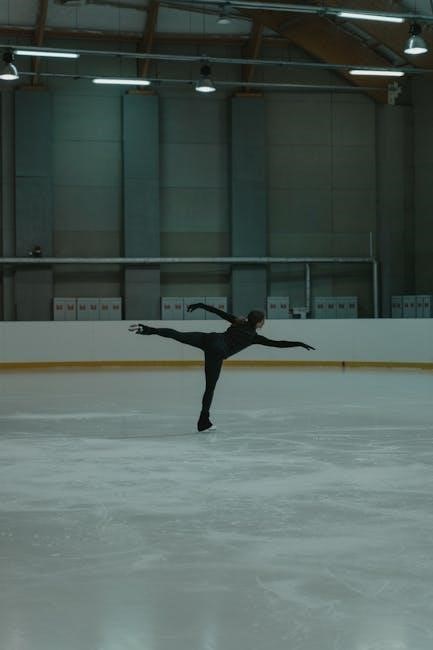
12-Week Suspension Training Program
A structured 12-week plan designed to progress from foundational movements to advanced exercises, enhancing strength, flexibility, and endurance through suspension training.
9.1 Weekly Workout Schedules
Each week is divided into 4-5 training days, targeting different muscle groups. Days focus on core, upper body, lower body, and full-body workouts. Includes warm-up routines, exercise sets, and cool-down stretches. Active recovery days are added to promote muscle repair and mobility. Schedules progress in intensity, ensuring balanced development and avoiding overtraining.
9.2 Gradual Increase in Intensity
Intensity is increased weekly by adjusting angles, reducing stability, or adding time under tension. Each phase introduces more challenging exercises or shorter rest periods. Progressive overload ensures continuous improvement without plateauing. Modifications are tailored to individual fitness levels, ensuring safe and effective progression. Proper form is maintained to prevent injury during intensity advancements.
9;3 Sample Workout Circuits
Sample circuits combine 4-6 exercises, focusing on full-body engagement. Examples include TRX Chest Press, Suspension Lunges, and Plank Rows. Each exercise is performed for 45-60 seconds, with 15-30 seconds rest between sets. Circuits are repeated 2-3 times, varying exercises weekly to target different muscle groups and maintain variety. This structure enhances endurance, strength, and coordination effectively.
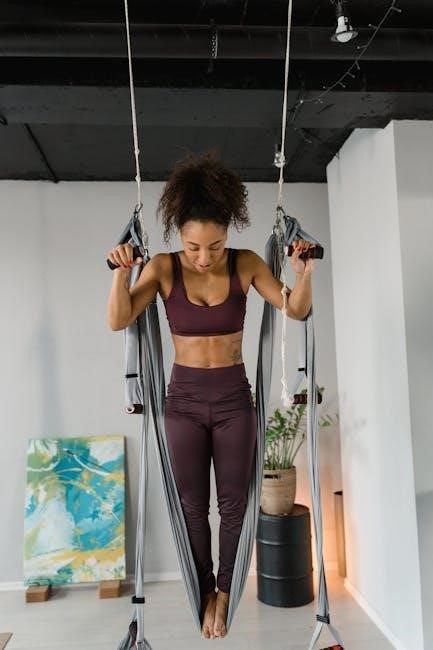
Additional Resources
- TRX Setup Guide PDF: Step-by-step installation instructions.
- TRX Quick Start Guide: Essential exercises for beginners.
- TRX Exercise Library: Comprehensive list of movements.
- 12-Week Program PDF: Structured workout plans.
10.1 TRX Setup Guide PDF
The TRX Setup Guide PDF provides a comprehensive overview for installing and configuring your suspension trainer. It includes step-by-step instructions, safety checks, and tips for securing anchor points. Learn how to adjust the straps to the correct height and understand proper setup techniques. This guide is essential for new users, ensuring a safe and effective training experience.
10.2 TRX Quick Start Guide
The TRX Quick Start Guide offers a fast-track introduction to suspension training. It outlines essential exercises, proper form, and safety tips, allowing users to begin training immediately. Designed for newcomers, this guide focuses on foundational movements and progressions, ensuring a smooth transition into more advanced routines. It’s perfect for those eager to start their fitness journey with suspension training.
10.3 TRX Exercise Library
The TRX Exercise Library provides an extensive collection of suspension training exercises. It includes detailed instructions, videos, and images for each movement, catering to all fitness levels. From foundational techniques to advanced variations, the library helps users master proper form and progression. Ideal for both beginners and experienced trainers, it serves as a comprehensive resource to maximize suspension training workouts effectively and safely.
Suspension training offers a versatile, effective way to build strength and flexibility. With its portable design and scalable exercises, it’s ideal for all fitness levels. Start today and transform your body with consistent practice and dedication to the routines outlined in this guide.
11.1 Summary of Benefits
Suspension training enhances strength, flexibility, and balance by engaging the core in every exercise. It improves overall stability and posture while being low-impact, reducing injury risk. Portable and versatile, it suits all fitness levels, offering a full-body workout. Regular practice boosts metabolism, increases muscle endurance, and improves coordination, making it an efficient and effective training method for achieving fitness goals.
11.2 Encouragement to Start Training
Embrace suspension training and transform your fitness journey. It’s accessible, versatile, and effective for all levels. Start with basic exercises, progress gradually, and enjoy the rewarding results. Every session brings you closer to a stronger, leaner, and more confident you. Take the first step today and experience the empowering benefits of suspension training for yourself!
11.3 Final Tips for Success
Consistency is key to achieving results with suspension training. Focus on proper form to prevent injuries and maximize effectiveness. Gradually increase intensity to avoid plateaus. Stay motivated by tracking progress and celebrating small victories. Incorporate variety to keep workouts engaging. Use resources like the TRX Setup Guide and Quick Start Guide for guidance. Stay committed, and enjoy the transformative benefits of suspension training!